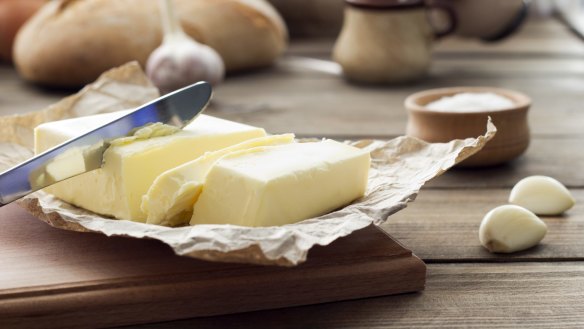Why do some recipes call for unsalted butter - then add salt?

I've often wondered why some cake recipes call for unsalted butter, then add salt. Anonymous
By using unsalted butter, recipe writers can determine the level of salt in the end product. This becomes important when using different brands of butter. Lurpak salted butter contains 480 milligrams of sodium per 100 grams or roughly 1.2 per cent salt, while Devondale salted butter contains 695 milligrams of sodium or around 1.73 per cent salt. For some, that can make quite a difference to the taste of a cake.
What's the best way to open a difficult jar? (Part II) O. Purdey
Two weeks back, we discussed ways of removing the lid stuck fast to a jar. Your response was overwhelming, so much so that I think there could be a small book in it. Reader M. Hansford dons the rubber gloves when her pickle jars won't budge. Other readers, too, said that slipping on a pair of Ansells can give extra friction in the stuck-lid department. D. Cunnington suggested a two-person operation in which one held the jar and the other person the lid, with both turning in the opposite direction. J. Laurie wrote in and suggested not to immerse the entire jar in warm water but to run hot water over the lid only to loosen the seal and expand the lid. Many of you suggested inserting the blade of a knife, preferably an older one, under the rim of the lid, and levering the side of the lid until the seal is broken. Others suggested using the tip of a spoon or the flat end of pressed steel cutlery. So as not to create work for Slater & Gordon, may I recommend wearing protective eyewear. Old butter knives are brittle and have been known to snap. Thank you to all of you who recommended a device called the JarKey. It is made of durable moulded plastic and has a tongue that fits under the lid. You lever the JarKey up, and it pops the seal. Look for it at places such as Howards Storage World and Peter's of Kensington.
My wee doesn't smell after I eat asparagus. L. Gillespie
For goodness' sake. Enough with the toilet talk. I try to run a classy show here. Asparagus contains a compound called asparagusic acid. When you eat asparagus, your body breaks down this acid into odourous and volatile sulfurous compounds, including dimethyl sulfide, dimethyl disulfide, dimethyl sulfoxide and dimethyl sulfone. Some people don't produce the enzyme that breaks down asparagusic acid. Some people can't detect the sulfurous compound. Whether your wee smells or not, after eating asparagus, is up for others to determine.
I love Melbourne, especially for the city's attitude to food and the loving attention to detail given to its production and preparation. So please, can you tell me, why can't you get a proper bagel here in Melbourne? An authentic bagel. It's hard/chewy on the outside – the inside is not like bread. M. Lowe
A bagel that fits that description is made by Five & Dime Bagels - see 5dimebagel.com.au
Send your vexing culinary conundrums to brainfood@richardcornish.com.au or tweet or insta @foodcornish
- More:
- Food
- Brain food
